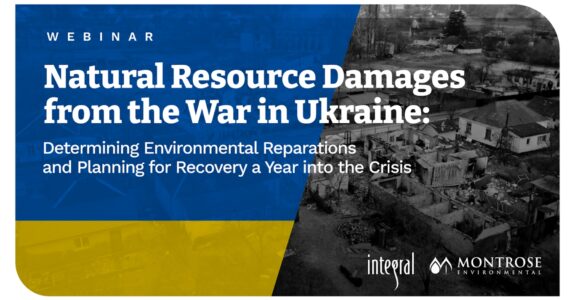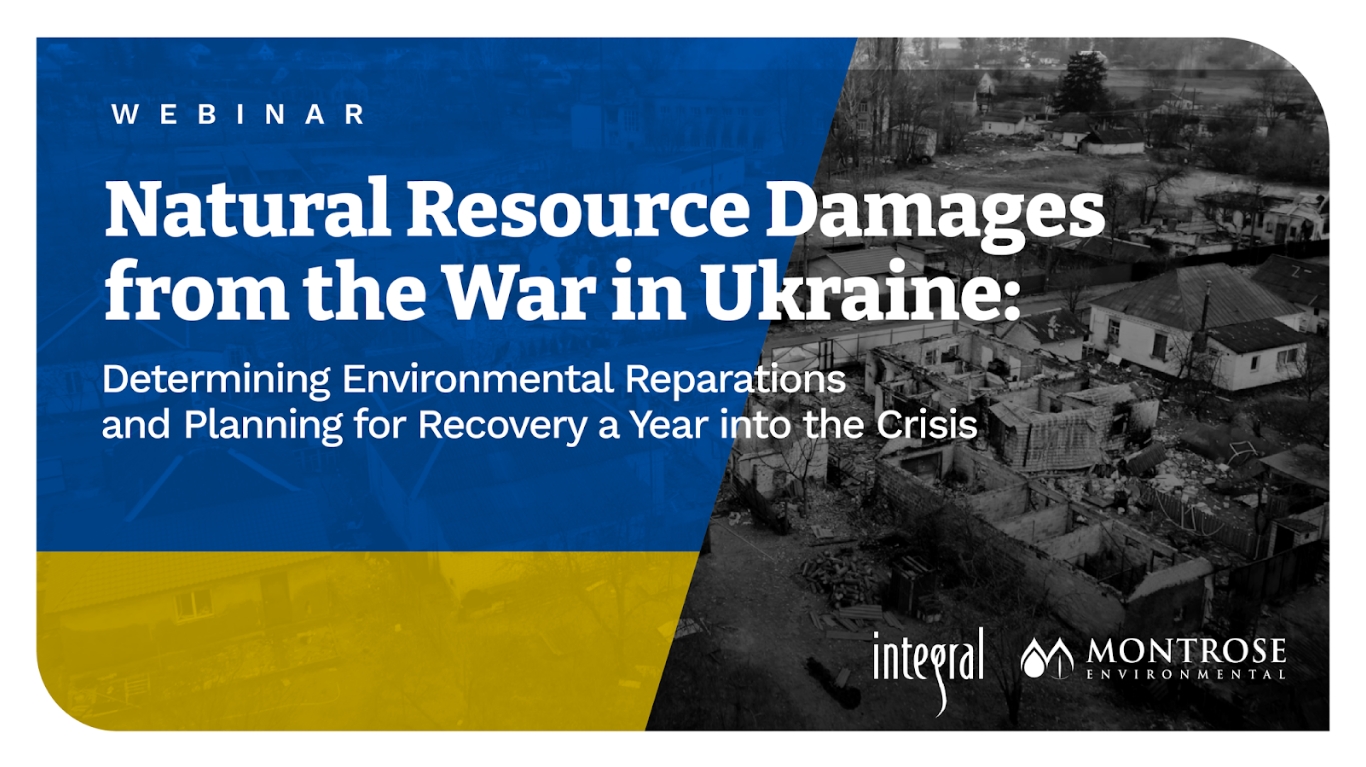
How do you determine baseline injuries for the Ukraine War?
August 7, 2023
By: Richard Wenning, PhD and Ted Tomasi, PhD
Defining Baseline
It is common in contemporary environmental assessment and regulation to understand the environmental baseline condition with respect to any human activity that has the potential to alter the environment. The baseline condition is usually understood as the ‘natural’ or ‘historical’ state of an ecosystem and components of that ecosystem (e.g., biodiversity, the population of a particular species, or the ambient level of nutrients or pollutants in air, soil, or water) before the environmental change. Determining baseline conditions is common in ecological restoration since there must be a historical benchmark against which the changed ecosystem (for whatever reason) is compared, and the goals for recovery are identified.
The information and data collected from the examination of historical records and surveys of comparable unaffected environments play an important role in the determination of the baseline condition. This information, in turn, influences the choices of investigations and analysis deployed to quantify the nature and extent of the injuries to the environment. Hence, it is important to learn as much as possible about the environment and the ecological and human use services provided by the environment early in the damage assessment process.
With respect to the consideration of degraded environments prior to the injury, damage assessment by definition is concerned only with new injuries and/or further degraded conditions to resources. By definition, if the air, soil, or water are known to be degraded before the injury, the baseline condition is represented by the state of the air, soil, or water in its degraded condition at the onset of the injury. Under US law, for example, the responsible party cannot be held liable for degraded environmental conditions irrespective of their actions.
Three basic principles to consider:
- Difference between primary and complementary restoration vs. compensatory restoration
- That restoration should be directed to the services provided by resources
- If methods used to measure damages are tied to the cost of restoration or are separately determined from how monies will be spent
Primary and complementary restoration vs. Compensatory restoration
Primary and complementary restoration replace the capacity of the environment to produce services. A different bio-physical arrangement of ecosystem elements could be used to replace lost services. For example, injuries to river sediments affected by war-related pollution could be restored by creating a riparian buffer zone or repairing failing septic systems that enhance water quality by reducing nutrient loadings, thereby restoring aquatic functioning and services. Compensatory restoration addresses the loss of aquatic services prior to return to baseline. This is beyond the baseline, by definition.
As an analogy, suppose a dead tree on a neighbor’s property falls on your home, crushing the roof over the bedroom and bathroom. The roof needs to be replaced, but it need not be the exact roof as harmed (e.g., because newer, perhaps better, roofing materials will replace the older worn materials that were harmed). It is possible the monies will result in a better roof, but not a substantially more elaborate roof. The neighbor has no responsibility for paying to upgrade the house in general because of the fallen tree. For example, the neighbor would not be responsible for installing solar panels as part of the repairs to the roof. However, you had to sleep in the living room and use a portable toilet during the repair work. Compensatory restoration pays for that additional loss; it takes the form of an enhancement of your property in some way, above its baseline condition (beyond the new roof), perhaps by providing a bathroom with a feature it did not have, a replacement of old kitchen appliances not damaged by the tree, or a roof with solar panels. In this same way, compensatory restoration for interim lost resource services is always above baseline.
International and Domestic Frameworks
Current international frameworks for environmental/ecological recovery are increasingly planning for climate change and encouraging – by necessity – that restoration work aims to return the environment to a stable condition beyond the baseline. The United Nations General Assembly (2016) and UN Office for Disaster Risk Reduction advocate ‘build back better’ in disaster recovery, rehabilitation, and reconstruction work to increase the resilience of environmental and critical infrastructure, social networks, and economies. Increasingly, local and regional environmental/ecological recovery plans are intentionally on trajectories from degraded conditions toward more resilient and sustainable improved conditions. Environmental restoration experts in the US and elsewhere advocate that simply “rolling back” the consequences of environmental injuries to a baseline condition may not be advisable because many ecological trajectories have been irreversibly altered by climate change and a wide range of human activities.
The same is true in the US. The Superfund program addressing the cleanup of contaminated sites, for example, advocates the concept of “ecological revitalization” to identify environmental recovery actions that both repair damages caused by responsible parties and set the trajectory for resource recovery on a path toward long-term sustainable use. This is predicated on the concept of a ‘shifting baseline’ largely prompted by climate change, which has irrevocably altered what is possible regarding habitat restoration. In the Columbia River basin, for example, where the work to recover natural resource damages has been underway for more than a decade, a shifting environmental baseline condition introduced by climate change has prompted a re-consideration of ecological management goals. Rolling back the clock to pre-injury conditions is no longer attainable or desirable for long-term environmental quality and social health.
References:
- A systematic review of ecological attributes that confer resilience to climate change in environmental restoration
- 2017 UNISDR – Build Back Better
- What is Ecosystem Restoration?
- A global baseline for ecosystem recovery
- The Superfund Program: Protecting Healthy Communities, Advancing Environmental Protection
- Anticipatory practices: Shifting baselines and environmental imaginaries of ecological restoration in the Columbia River Basin
What’s next?
Our team will be exploring NRDA questions more deeply in this five-question blog series. Our goal is to help provide you with a better understanding of Natural Resource Damage Assessments and how the framework applies to the war in Ukraine. As always, we are here to answer any questions you may have. We look forward to helping you and your company achieve your NRDA goals and hope you tune in for our additional workshops and webinars.
5 Questions – Ukraine War and NRDA
Webinar: Natural Resource Damages from the War in Ukraine

Since the beginning of the war in February 2022, Ukraine’s land and water resources have been severely impacted by conflict. In this webinar, Dr. Tomasi and Dr. Wenning will explore a data-driven, science-based approach to estimating the restoration needed and its cost to compensate for the environmental impacts of war.
Presenters:
Richard Wenning, Ph.D., Senior Principal, Montrose
Ted Tomasi, Ph.D., Managing Principal, Integral Consulting
Blog Co-Authors
Richard Wenning, Ph.D.
Managing Principal
Mr. Wenning is an ecotoxicologist with 37 years of experience in environmental impact and ecological risk assessment. He has used decision analysis tools, such as net environmental benefits analysis (NEBA) and comparative risk and remedy alternatives analysis (CRA/RAA), to help companies and governments develop strategies to restore damaged aquatic and terrestrial ecosystems. He has worked on environmental assessments of major human-caused pollution incidents and natural disasters, such as the Deepwater Horizon oil spill in the Gulf of Mexico and Brazil’s Samarco mine tailing dam failure. Mr. Wenning also has experience working in regions across the world, including Asia/Pacific, Australia, Europe, the Middle East, and southern Africa.
Theodore D. Tomasi, Ph.D.
Managing Principal
Dr. Ted Tomasi has more than 30 years of experience as a natural resource economist, specializing in the valuation of natural resources and environmental changes, risk management in the context of use decisions regarding resource use, and benefit–cost analysis. Before beginning his consulting career, he served on the faculties of the University of Minnesota, the University of Michigan, and Michigan State University, where he taught and conducted research on environmental policy analysis, decision-making under uncertainty, and methods for valuing ecosystem services. Dr. Tomasi served as an advisor and economic expert for NOAA’s Damage Assessment Center and sat on expert review panels for the Type-A natural resource damage assessment (NRDA) model for both the Great Lakes and the coastal and marine environments. He has published numerous book chapters and peer-reviewed journal articles, and is a sought-after speaker in the area of environmental damage claims.









